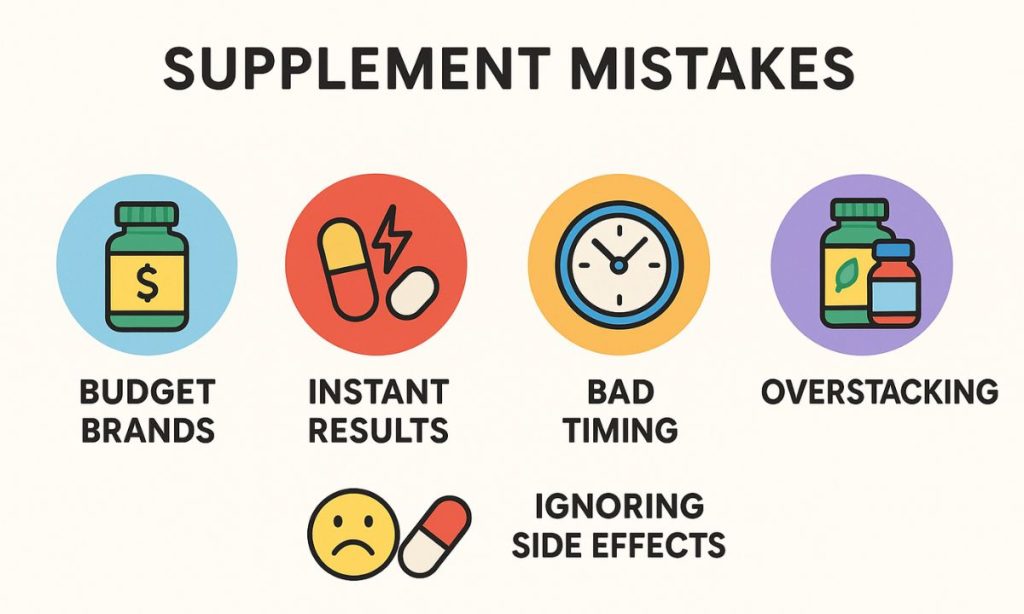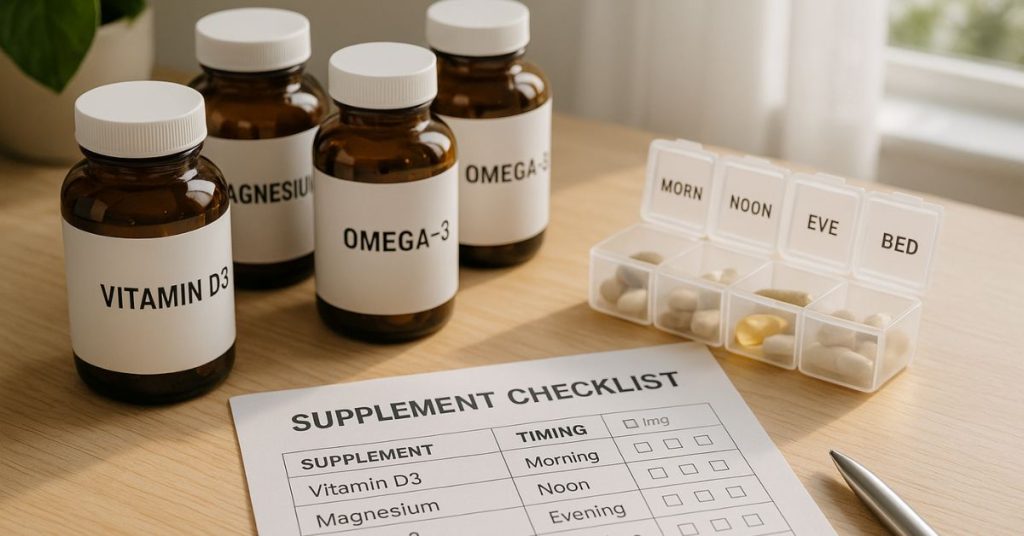Supplements can be the missing piece in your health plan — the final push that helps you hit your goals faster. But they can also be a money pit that leaves you frustrated, wondering why nothing’s working.
Here’s the uncomfortable truth: Most beginners don’t fail because the supplements are bad. They fail because they make the same handful of rookie mistakes over and over again.
Some of these mistakes are harmless but wasteful. Others can actually put your health at risk. Either way, they’ll drain your wallet and delay your results.
This guide breaks down the 5 most common rookie supplement mistakes and exactly how to avoid them, so you can spend your money smarter and see real benefits.
This post may contain affiliate links. If you click and buy, I may earn a small commission at no cost to you. I only recommend products I use, trust, or have thoroughly researched.

Mistake #1: Buying Whatever’s on Sale (Without Checking Quality)
That $5 multivitamin from the discount bin might feel like a win — until you realize it’s mostly fillers and underdosed ingredients.
The supplement industry isn’t as tightly regulated as prescription drugs. That means quality control can vary wildly, even between brands you see in the same store aisle.
Why It’s a Problem:
- Cheap supplements often use inferior forms of nutrients that your body doesn’t absorb well.
- They may skip third-party testing, so label claims aren’t always accurate.
- Contamination is a real concern — everything from heavy metals to banned substances has been found in low-quality products.
How to Avoid It:
- Look for third-party certifications like NSF, USP, or Informed Choice.
- Research the forms of nutrients — for example, magnesium glycinate is more bioavailable than magnesium oxide.
- Stick with brands that publish lab test results for transparency.
Mistake #2: Expecting Instant Results
This might be the biggest myth in the supplement world — the idea that you’ll take a capsule and feel a life-changing difference by the next morning.
Unless you’re correcting a severe deficiency, most supplements take weeks (sometimes months) to show results.
Why It’s a Problem:
- People quit too soon, thinking the supplement “doesn’t work.”
- They jump from product to product, never giving anything a fair trial.
- This leads to wasted money and zero measurable progress.
How to Avoid It:
- Commit to 4–8 weeks before deciding if a supplement is helping.
- Track changes in energy, mood, sleep, and performance — don’t just rely on memory.
- Combine supplements with the basics: good nutrition, exercise, and sleep.

Mistake #3: Taking Supplements at the Wrong Time
When you take your supplements matters. Some need food, others don’t. Some are better in the morning, others before bed. Get this wrong, and you might as well be throwing your pills in the trash.
Examples:
- Fat-soluble vitamins (A, D, E, K) — need dietary fat to absorb.
- Magnesium — has a calming effect; best in the evening.
- Caffeine-based fat burners or pre-workouts — too late in the day can ruin your sleep.
- Iron — absorbs best on an empty stomach but can cause nausea for some.
How to Avoid It:
- Read the label for timing instructions.
- Group supplements into with-food and without-food batches.
- Spread doses throughout the day to improve absorption and reduce stomach upset.
Mistake #4: Ignoring Side Effects & Interactions
Natural doesn’t always mean safe. Supplements can interact with medications or cause unwanted side effects.
Why It’s a Problem:
- May cause symptoms like headaches, nausea, or rapid heart rate.
- Can interact with prescription drugs (example: fish oil + blood thinners).
- Long-term overuse can stress the liver or kidneys.
How to Avoid It:
- Research each supplement before buying — use reputable sources.
- If you take prescription meds, check for known interactions.
- Start with lower doses to see how your body reacts.
Mistake #5: Stacking Too Much, Too Soon
It’s tempting to build a giant “everything stack” on day one. The problem? You won’t know what’s helping — or what’s causing side effects.
Why It’s a Problem:
- Impossible to track which supplement is effective.
- Increases risk of side effects.
- Can overwhelm your system.
How to Avoid It:
- Start with one or two targeted supplements based on your goals.
- Add new ones slowly, monitoring results each time.
- Reassess your stack every 3–6 months.
Skip These Beginner Mistakes: Quick Checklist
- ✅ Research brands before buying
- ✅ Give supplements time to work
- ✅ Time doses for maximum absorption
- ✅ Check for interactions and side effects
- ✅ Start small, stack slowly
Side Effects & Interactions Chart
| Supplement Type | Possible Side Effects | Common Interactions |
|---|---|---|
| Caffeine-based | Jitters, insomnia, anxiety | Sleep meds, heart meds |
| Fish oil | Stomach upset, bleeding risk | Blood thinners, aspirin |
| Magnesium | Loose stools, cramping | Certain antibiotics |
| Vitamin K | Blood clotting changes | Warfarin, anticoagulants |
| Iron | Constipation, nausea | Calcium, thyroid meds |
Brand Recommendations Worth Buying
These brands consistently deliver on quality, safety, and transparency:
- Life Extension – Science-backed formulas, lab-tested for purity.
- NOW Foods – Affordable, widely available, third-party verified.
- Thorne Research – High absorption rates, NSF certified.
- Jarrow Formulas – Balanced pricing and reliable quality control.
If you’re just getting started and want a complete game plan, check out our guide: How to Start Taking Supplements: A Beginner’s Blueprint.